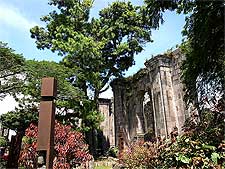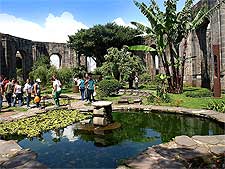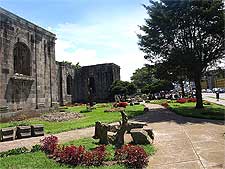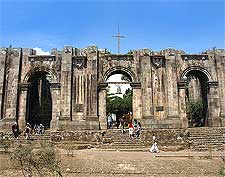Cartago History Facts and Timeline
(Cartago, Costa Rica)

The history of Cartago is surprisingly more impressive than that of the capital,
San Jose, since it's much older and also the original capital of Costa Rica.
A myriad of historical sites and subsequent ruins, containing a somewhat preserved city centre, are scattered about the area. Highlights include the Black Madonna and the central Plaza Mayor park.
Cartago Establishment
Spanish conquistador Juan Vásquez de Coronado established Cartago in 1563, between the Purires and Coris rivers, off to the south-west of the city today. The area was home to indigenous peoples, who the new settlers set about converting to Christianity. Spain's King Philip II granted Cartago a coat of arms in 1565 and bestowed an honour on the town, stated as 'Very Noble and Very Loyal' (Muy Noble y Muy Leal).
Cartago was later moved closer to present-day San Jose due to consistent flooding, earning it the moniker 'City of Mud'. The original church of the new site today remains as a 'rebuilt' ruin. Known as the Ruins of the Church of the Parish (Las Ruinas de la Parroquia), or simply 'La Ruinas', the church succumbed to earthquake damage over the years, but still stands near the Plaza Mayor. Quircot Church, just outside of Cartago, is another popular church of this time and dates from the latter part of the 1500s.

The Black Madonna
The most important historical icon of Cartago is contained in the Basilica of Our Lady of the Angels, not far from La Ruinas. This impressive church is the focal point of a congregation every year to honour a carved image of the Virgin Mary, the Black Madonna (La Negrita). It was originally spotted by a native girl in 1635.
Although the original settlers were moved to a new town nearby, they were later moved back to present-day Cartago, after improvements to land drainage and housing corrected earthquake damage. Historically, Cartago thus remained the Costa Rican provincial capital through to the end of its colonial period. That changed after the Mexican War of Independence saw the Spanish defeated and Central America proclaimed independent in 1821.
The capital was moved to San Jose (by Gregorio Jose Ramirez) in 1823, since this city in the north-west supported the idea of republic. Cartago, however, preferred to join the Mexican Empire and, as a result, it was downgraded to provincial capital under the new republic.

Coffee and Earthquakes
Coffee came on the scene in Central and South America in the 1800s and became Costa Rica's saviour. It was mainly grown around the Central Plateau, including in Cartago and San Jose, and was being shipped off to Europe by the boatload by the 1840s.
Cartago, along with San Jose, continued to suffer earthquake and volcano damage through its history. Earthquakes have struck most recently in 1822, 1841 and 1910, destroying many buildings.

The Plaza Mayor
Today, the Plaza Mayor is regarded as the centre of the city, containing the Santiago Apostol Parish Ruins. The historical area actually covers a hundred blocks, in a bid to protect the history of Cartago. The City Museum is near here, formerly the Cuartel de la Ciudad, and is where you can learn more about the region's past.
Most locals tend to work in agriculture nearby, or in the metropolitan San Jose area. Cartago has industries within the city, but it is largely quiet and not as bustling as the capital. It is thus hugely popular with tourists interested in history, and is frequently used as a launch point for visits to nearby tropical rainforests and volcanoes.
 The history of Cartago is surprisingly more impressive than that of the capital, San Jose, since it's much older and also the original capital of Costa Rica.
The history of Cartago is surprisingly more impressive than that of the capital, San Jose, since it's much older and also the original capital of Costa Rica.

